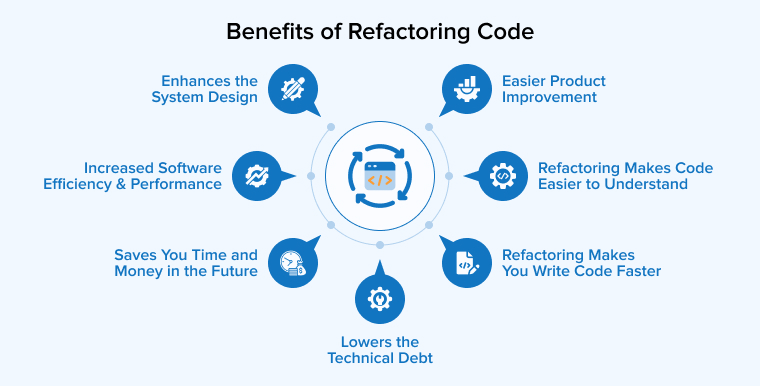
Consistent improvement is a way businesses keep their pace and make their way to the advanced business app. Developing an application needs a lot of restructuring, existing code changes, quality improvement changes, and so on, to get the coding right. Refactoring is one of several such tasks and appears to be less concrete than testing. The client asks a fair question: “If it works, why do we need to refactor the code?” Nevertheless, the importance of source code cleanup may not always be obvious. The advantages of refactoring are covered in the article, along with its benefits.
If you are still on the fence and unable to understand what the refactoring process is, then as a software development service provider we take this responsibility to give you clear insight on this subject and develop this article for you. From this blog, we will be going through the process and advantages of refactoring and understanding the why, when, and what of refactored code. So, let’s dive into it.
1. What is Refactoring?
Code refactoring is a method of altering and cleaning up application code in the background, optimizing its internal structure but leaving its external behavior and functionalities untouched. Nevertheless, this is a necessary component of every project development. To outside observers, the requirement of code reworking might not be entirely clear.
Even a poor project design can be improved by refactoring. By code refactoring, all you aim for is to change the internal structure of the codes. This has some long-term benefits and that is the only reason why refactoring existing code is of good value.
2. When Should the Code Be Refactored?
If you have understood the process of code refactoring, you will understand why it is important to integrate refactoring into your development process. Finding the ideal moment for refactoring is not difficult. The following are some frequent scenarios where it is worthwhile to act.
There is a buildup of technical debt. When similar tasks begin to take longer to complete than they did at project launch but do not vary in complexity, this is an obvious sign of accumulated technical debt. It indicates that the project has architectural flaws, an increase in the complexity and confusion of its code, and challenges with scalability.
3. Advantages of Refactoring
Here are the advantages of refactoring:

3.1 Enhances the System Design
When you make code improvements and have a deeper understanding of your project, you gradually discover new things. If you merely pay attention to your code for a few months after you implement a feature, you will discover that it can be written more simply and easily. The approach you took months ago probably isn’t the best one now. By reworking your code and adhering to basic best practices, you can enhance the overall design of your application.
In the short term, software with a poor design may be beneficial, but in the long run, it might lead to a lot of problems. Spending time on code reworking and adhering to best practices will help you avoid problems in the future.
3.2 Refactoring Makes Code Easier to Understand
When you start to add some of the additional features, the development process might be challenging. However, maintaining the outdated code in a legacy application is an even more difficult process. However, the most effective technique is iterative refactoring which can lower the technical glitches of legacy code. Refactoring the code can make it simple to comprehend and use going forward. Some actions you do during this process include:
- Removing unnecessary complexity or features to simplify things.
- Deleting any code snippets that would no longer be required.
- Creating smaller versions of larger classes and functions.
- You are developing the code for two readers each time you create a new feature.
3.3 Increased Software Efficiency & Performance
The main reason why businesses consider the process is because code restructuring increases efficiency. Developers may waste too much time trying to find bugs and errors and updating every line of code if the old code is clumsy and voluminous. For quick and effective work with the code, code refactoring is a need. Spend money on code reworking now to save a ton of time and money later on.
Because refactored code is simpler, systems respond more quickly. Users won’t have to worry as much about missing deadlines since the system responds slowly and will be able to complete their duties more quickly. The outputs expected from this are more customers, higher revenue, and significantly satisfactory end user experience.
3.4 Refactoring Makes You Write Code Faster
Refactoring improves the design and overall process and makes it faster. So, when you have bigger projects, you are more likely to spend more time writing new code and less time refactoring. That doesn’t sound right at first. So what can be done for bigger projects if code refactoring takes time? Hence it is obvious that it causes the software development process to lag and will simply temporarily slow it down.
Your speed increases as you begin to add up the benefits of organizing your current code. Refactoring existing code gets simpler to modify. Additionally, you begin recycling source code in simple ways so that you don’t have to create them from scratch. This makes fixing bugs faster and the code structure will also be simplified and easier for the team to maintain and get a high level of code quality.
3.5 Lowers the Technical Debt
Clean code refactoring will make it easier for businesses to save their costs. Generally, the cost of software is not the exact cost that is released in the first version. The cost factor keeps on adding up as you add some extra features to your regular app. These updates might end up in technical debt. So, it is advisable to take advantage of refactoring and save on cost and time.
3.6 Easier Product Improvement
It is essential to design the product, as well as to add new functionality and features as well as update it periodically to fulfill consumer needs if you want to stay relevant. Years after the product is released, there is no other way to keep ahead of rivals except in that way. Due to the risk of breaking the entire program while attempting to improve the basic code, it is practically hard to do this successfully. Your products will always receive top-notch upgrades and popular additions thanks to code reworking, which can greatly increase sales.
3.7 Saves You Time and Money in the Future
Code refactoring on existing codes helps the software engineering team to save a lot of time and money. Understanding and implementing new features is quicker with clean, and straightforward code. No one likes to put their time into deciphering clumsy code or eliminating duplicate code. It takes a longer time to upgrade or extend the application that has not been refactored. In addition, if there are problems with the program, the company will need to spend more money to solve them, which will raise the budget.
4. What are the Goals of Code Refactoring?

When your development team is fully capable of refactoring the codes, the goals of better code structure and better app functionality can be easily expected. They must know that there are certain objectives that they should achieve as a business. Below are the objectives of code refactoring.
- Maintainability
Code refactoring’s primary objective is to make it simple to improve and maintain in the future. The Open Close Principle must not be broken. - Getting Rid of the Code Smells
Here the smell is a bad code smell. The need to refactor code is driven by bad code smell. It stops a number of potential flaws. - Reduced Code Size- For the codes that are unclear, can be easily corrected and restructured.
- Consistent results
When your codes are refactored, the ultimate aim of the software system is to deliver consistent results. The software refactoring process will clean all messy code or dirty code, clear the user interface, and deliver constant and continuous results.
5. When Code Should not be Refactored?
Code refactoring is not always necessary in all situations. In some business scenarios, code refactoring is not essential because starting from scratch is considerably more time and money-efficient than having to redo all the tasks for the application. This could occur if the code is utterly incomprehensible, or impossible, and in case you want to update or add new features to it. In other words, the application’s restructuring was not completed in a timely manner, which resulted in these critical issues.
As a result, it appears like more effort is being put into fixing errors and performing additional refactoring than towards completely redesigning the application. It is difficult to overstate the significance of code restructuring in such situations. If development has certain stringent deadlines and market delivery, it would be advisable to put off restructuring for a while.
6. Final Thoughts
Towards the end of this, we have a thorough understanding of the code refactoring meaning, how it works, when it is needed in the businesses, and what is the end result of an organized code. Code refactoring is a lengthy process and businesses with expertise can take advantage of the refactoring process. In case businesses are not sure, there are companies performing code refactoring activities for messy codes and delivering consistent, high-quality, and noteworthy results.






Comments
Leave a message...